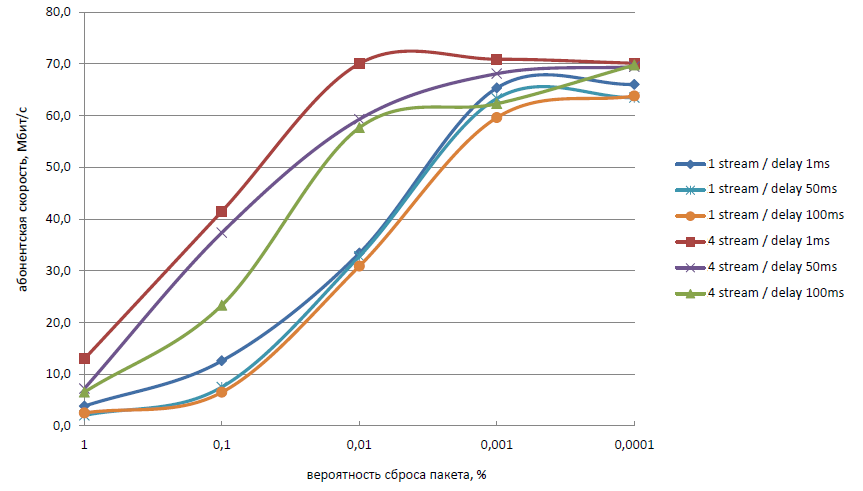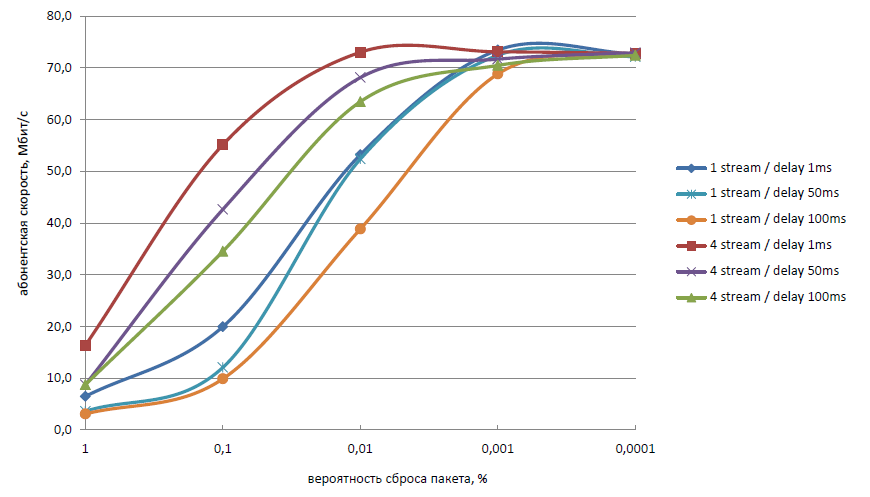How we tested the dependence of LTE speed on S1 parameters
It was a year ago. Start LTE launch with us in the Macro Region. In this case, the radio of one Korean vendor is a rarity, even on a global scale (no, the BS did not check on Anroid). It seems everything is taken into account, tests are carried out in the laboratory, diagrams and typical configurations are developed. Well, as usual, run. The launch is not with us, but in the neighboring region.
It seems to be close, but somehow the results are not encouraging - the subscriber speed is lower than the laboratory speed in the same radio conditions. And soon the launch of the network - you need to show the maximum,and not as competitors .
What to do? Gladly trashlshutit!
')

In fact, troubleshooting did not take much time and found the cause quickly - the main line. A quite good line for 2G and 3G turned out to be “so-so” for LTE. Transferred to the reserve - the problem is gone.
But the question arose - what do we need? What channel quality is required? 113 orders are carried out with a large margin, internal standards, too, but they are clearly not enough. Well, let's try to understand what is needed. We quickly assemble the laboratory, but just against S1 of the interface between the base station (BS) and the transport network we put a small assistant in the form of a server with Debian on board. Settings are searched surprisingly quickly and by the end of the day the lab is ready.
The scheme is very simple (the traffic path is indicated with a dotted line):

* MBH - mobile backhaul - transport network.
* EPC - evolved packet core - packet core.
Yes, why did you need a server counter? Make a loss and delay. Oddly enough, this turned out to be the easiest solution to imitate problems. Tc and nothing else is needed. The delay of the server itself is minimal.
The subscriber speed was measured quite honestly - a “whistle” on a laptop and an ftp server on the Internet. I'll run ahead and say that the sample was more or less honest - each of the possible options was measured 10 times. The best and the worst were discarded, the rest was averaged. However, errors are possible due to the imperfection of monitoring tools on the subscriber device. Although, as experience has shown, specialized complexes may also have problems with accuracy.
And one more clarification for ease of understanding the following results: 1 stream / 4 stream is the number of download streams. Those. either 1 or 4 files at the same time. The speed for 4 files is of course total. And yes, speedtest is several threads, so the 4-thread version is much closer to reality.
So, what happened:
1. Average speed:

2. Maximum speed:

The delay of course affects, but it is very difficult to minimize. Yes, and the main problems still because of the drops. Ministerial 10 -3 look very sad. It became obvious that our goal was at least an order of magnitude higher and to achieve it a set of measures was carried out. A 10 -5 already allows you to reach a maximum in almost all conditions. But it’s not always possible to reach 10 -5 , but that’s another story ...
It seems to be close, but somehow the results are not encouraging - the subscriber speed is lower than the laboratory speed in the same radio conditions. And soon the launch of the network - you need to show the maximum,
What to do? Gladly trashlshutit!
')

In fact, troubleshooting did not take much time and found the cause quickly - the main line. A quite good line for 2G and 3G turned out to be “so-so” for LTE. Transferred to the reserve - the problem is gone.
But the question arose - what do we need? What channel quality is required? 113 orders are carried out with a large margin, internal standards, too, but they are clearly not enough. Well, let's try to understand what is needed. We quickly assemble the laboratory, but just against S1 of the interface between the base station (BS) and the transport network we put a small assistant in the form of a server with Debian on board. Settings are searched surprisingly quickly and by the end of the day the lab is ready.
The scheme is very simple (the traffic path is indicated with a dotted line):

* MBH - mobile backhaul - transport network.
* EPC - evolved packet core - packet core.
Yes, why did you need a server counter? Make a loss and delay. Oddly enough, this turned out to be the easiest solution to imitate problems. Tc and nothing else is needed. The delay of the server itself is minimal.
The subscriber speed was measured quite honestly - a “whistle” on a laptop and an ftp server on the Internet. I'll run ahead and say that the sample was more or less honest - each of the possible options was measured 10 times. The best and the worst were discarded, the rest was averaged. However, errors are possible due to the imperfection of monitoring tools on the subscriber device. Although, as experience has shown, specialized complexes may also have problems with accuracy.
And one more clarification for ease of understanding the following results: 1 stream / 4 stream is the number of download streams. Those. either 1 or 4 files at the same time. The speed for 4 files is of course total. And yes, speedtest is several threads, so the 4-thread version is much closer to reality.
So, what happened:
1. Average speed:

2. Maximum speed:

The delay of course affects, but it is very difficult to minimize. Yes, and the main problems still because of the drops. Ministerial 10 -3 look very sad. It became obvious that our goal was at least an order of magnitude higher and to achieve it a set of measures was carried out. A 10 -5 already allows you to reach a maximum in almost all conditions. But it’s not always possible to reach 10 -5 , but that’s another story ...
Source: https://habr.com/ru/post/243433/
All Articles